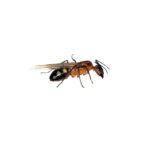Camponotus renggeri
40,00€ – 70,00€Price range: 40,00€ through 70,00€
Discover the Camponotus renggeri ant! A curious, exotic ant perfect for your artificial ant farm. Explore them today!
SKU:
N/A
Categories: Ants, Exotic ants
Description
Technical data sheet of the Camponotus renggeri ant
Scientific Name: Camponotus renggeri
Common Name: Carpenter ant
Taxonomic Classification:
- Kingdom: Animalia
- Phylum: Arthropoda
- Class: Insecta
- Order: Hymenoptera
- Family: Formicidae
- Genus: Camponotus
- Species: C. renggeri
Morphological Description:
- Size: Variable, ranging from 5 to 15 mm in length.
- Color: Mostly black with some reddish areas on the abdomen.
- Body: Segmented into head, thorax, and abdomen. The head is large compared to the rest of the body. Antennae are long and segmented.
- Mandibles: Strong and robust, used for manipulating food and defense.
- Eyes: Well-developed, usually black.
Habitat:
- Tropical and subtropical forests.
- Found in both arboreal and terrestrial habitats.
- Construct nests in decaying wood, under tree bark, or in the ground.
Geographical Distribution:
- Primarily found in South America, including countries such as Brazil, Argentina, Paraguay, and Uruguay.
- Populations have also been recorded in regions of Central America.
Feeding Habits:
- Omnivorous, feeding on a wide variety of sources including nectar, fruits, dead insects, and other small invertebrates.
- Can establish symbiotic relationships with certain plant species that provide them with nectar or protection.
Behavior:
- Social ants, organized into colonies with a defined hierarchy.
- Colony sizes can vary from a few hundred to several thousand individuals.
- Exhibit foraging behavior both during the day and night, depending on environmental factors and resource availability.
- Communication: Utilize a combination of pheromones and tactile communication to coordinate activities within the colony.
Ecological Importance:
- Play a crucial role in forest ecosystems as predators and decomposers, controlling insect populations and aiding in the decomposition of organic matter.
- Some species of Camponotus may also be important seed dispersers.
Additional information
| Options |
Queen ,Queen with 1-5 worker ants ,Queen with 6-10 worker ants |
|---|
Related products
Camponotus turkestanus
20,00€ – 60,00€Price range: 20,00€ through 60,00€
Sold out
Select options
This product has multiple variants. The options may be chosen on the product page
Camponotus Mutilarius (Xiangban)
25,00€ – 80,00€Price range: 25,00€ through 80,00€
Sold out
Select options
This product has multiple variants. The options may be chosen on the product page
Camponotus vanispinus
25,00€ – 38,00€Price range: 25,00€ through 38,00€
Sold out
Select options
This product has multiple variants. The options may be chosen on the product page
Camponotus maculatus Queen
45,00€ – 70,00€Price range: 45,00€ through 70,00€
Sold out
Camponotus maculatus Camponotus maculatus Origin and distribution: Angola, Benin, Cameroon, Central African Republic, Mozambique, Namibia, Saudi Arabia, Senegal, South Africa,
Select options
This product has multiple variants. The options may be chosen on the product page
Camponotus nicobarensis
15,00€ – 50,00€Price range: 15,00€ through 50,00€
Sold out
Camponotus nicobarensis Origin and distribution:: Nicobar Island, Bangladesh, India, Laos, Vietnam, Thailand, China. Humidity: 50 – 70% Temperature: 24 –
Select options
This product has multiple variants. The options may be chosen on the product page























